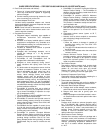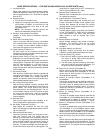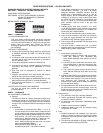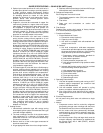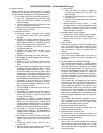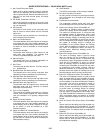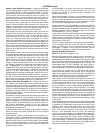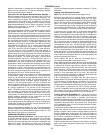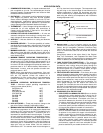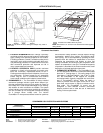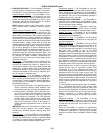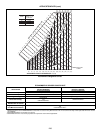292
CONTROLS (cont)
If field-installed accessory CO
2
sensors are connected to the
EconoMi$er IV control, a demand controlled ventilation strategy
will begin to operate. As the CO
2
level in the zone increases
above the CO
2
set point, the minimum position of the damper
will be increased proportionally. As the CO
2
level decreases
because of the increase in fresh air, the outdoor-air damper will
be proportionally closed.
For EconoMi$er IV operation, there must be a thermostat call
for the fan (G). If the unit is occupied and the fan is on, the
damper will operate at minimum position. Otherwise, the
damper will be closed.
When the EconoMi$er IV control is in the occupied mode and a
call for cooling exists (Y1 on the thermostat), the control will first
check for indoor fan operation. If the fan is not on, then cooling
will not be activated. If the fan is on, then the control will open
the EconoMi$er IV damper to the minimum position.
On the initial power to the EconoMi$er IV control, it will take the
damper up to 2
1
/
2
minutes before it begins to position itself. Any
change in damper position will take up to 30 seconds to initiate.
Damper movement from full closed to full open (or vice versa)
will take between 1
1
/
2
and 2
1
/
2
minutes.
If free cooling can be used as determined from the appropriate
changeover command (switch, dry bulb, enthalpy curve, differ-
ential dry bulb, or differential enthalpy), then the control will
modulate the dampers open to maintain the mixed-air tempera-
ture set point at 50 to 55 F.
If there is a further demand for cooling (cooling second stage —
Y2 is energized), then the control will bring on compressor
stage 1 to maintain the mixed-air temperature set point. The
EconoMi$er IV damper will be open at maximum position.
EconoMi$er IV operation is limited to a single compressor.
Heating, Units With Economizer
NOTE: The units have 2 stages of heat.
When the thermostat calls for heating, power is sent to W1 on
the IGC (integrated gas unit controller) board. An LED (light-
emitting diode) on the IGC board will be on during normal oper-
ation. A check is made to ensure that the rollout switch and limit
switch are closed and the induced-draft motor is running. The
induced-draft motor is then energized, and when speed is
proven with the hall effect sensor on the motor, the ignition acti-
vation period begins. The burners will ignite within 5 seconds.
If the burners do not light, there is a 22-second delay before
another 5-second attempt. If the burners still do not light, this
sequence is repeated for 15 minutes. After the 15 minutes have
elapsed, if the burners still have not lit, heating is locked out. To
reset the control, break 24-v power to the thermostat.
When ignition occurs the IGC board will continue to monitor the
condition of the rollout and limit switches, the hall effect sensor,
as well as the flame sensor. If the unit is controlled through a
room thermostat set for fan auto., 45 seconds after ignition
occurs, the indoor-fan motor will be energized (and the outdoor-
air dampers will open to their minimum position). If for some
reason the overtemperature limit opens prior to the start of the
indoor fan blower, on the next attempt, the 45-second delay will
be shortened to 5 seconds less than the time from initiation of
heat to when the limit tripped. Gas will not be interrupted to the
burners and heating will continue. Once modified, the fan on
delay will not change back to 45 seconds unless power is reset
to the control.
When additional heat is required, W2 closes and initiates power
to the second stage of the main gas valve. When the thermostat
is satisfied, W1 and W2 open and the gas valve closes, inter-
rupting the flow of gas to the main burners. If the call for W1
lasted less than 1 minute, the heating cycle will not terminate
until 1 minute after W1 became active. If the unit is controlled
through a room thermostat set for fan auto., the indoor-fan
motor will continue to operate for an additional 45 seconds then
stop (and the outdoor-air dampers will close). If the overtemper-
ature limit opens after the indoor motor is stopped within
10 minutes of W1 becoming inactive, on the next cycle the time
will be extended by 15 seconds. The maximum delay is 3 min-
utes. Once modified, the fan off delay will not change back to
45 seconds unless power is reset to the control.
When the thermostat is satisfied and W1 and W2 are deener-
gized, the IFM continues to run and the economizer damper
then moves to the minimum position.



